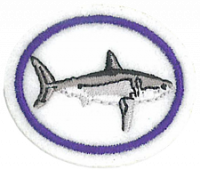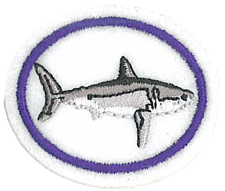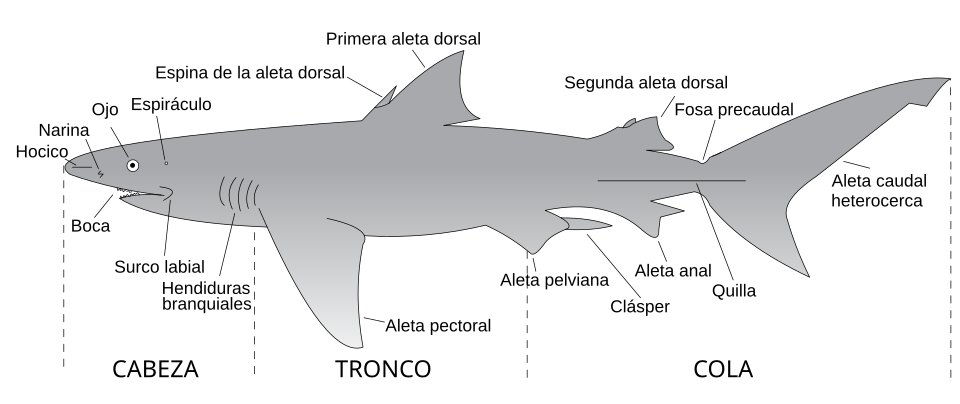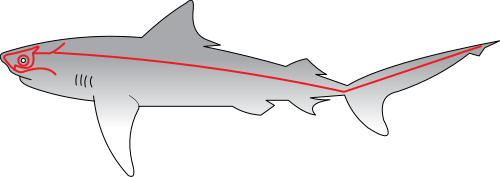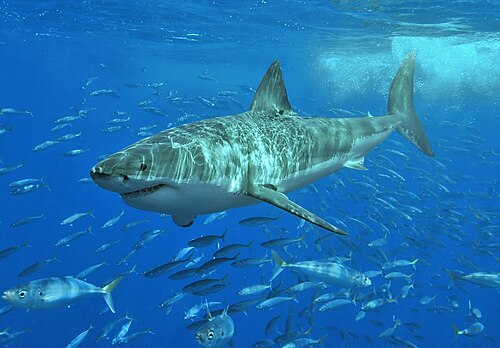Respuestas para la especialidad JA de Tiburones
1
Los tiburones fueron creados en el quinto día:
Dijo Dios: «Produzcan las aguas seres vivientes, y aves que vuelen sobre la tierra, en el firmamento de los cielos.» Y creó Dios los grandes monstruos marinos y todo ser viviente que se mueve, que las aguas produjeron según su especie, y toda ave alada según su especie. Y vio Dios que era bueno. Y los bendijo Dios, diciendo: «Fructificad y multiplicaos, llenad las aguas en los mares y multiplíquense las aves en la tierra.» Y fue la tarde y la mañana del quinto día.
2
El estudio de la subclase de peces conocidos como cartilaginosos (el esqueleto está hecho de cartílago como en la nariz de una persona, sin huesos), incluyendo los tiburones, rayas y rájidos, se llama elasmobranquiología. Estos peces se les denomina colectivamente elasmobranquios.
3
Los tiburones son un grupo de peces que se caracteriza por un esqueleto cartilaginoso (cartílago, no hueso), de cinco a siete hendiduras branquiales en los lados de la cabeza por donde respiran, y las aletas pectorales que no están fundidas a la cabeza. Los tiburones tienen una cubierta de dentículos dérmicos que protege su piel del daño y parásitos además de mejorar su dinámica de fluidos. Tienen varios juegos de dientes reemplazables. Los tiburones modernos se clasifican dentro del clado Selachimorpha (o Selachii) y son el grupo hermano de las rayas.
Hay alrededor de 470 especies de tiburones que varían en tamaño desde el tiburón linterna enano (Etmopterus perryi), una especie de aguas profundas de sólo 17 centímetros de longitud, hasta el tiburón ballena (Rhincodon typus), el pez más grande en el mundo, que alcanza aproximadamente 12 metros. Los tiburones se encuentran en todos los mares y son comunes a profundidades de 2.000 metros. Generalmente no viven en agua dulce, aunque hay algunas excepciones conocidas, tales como el tiburón toro (o sarda) y el tiburones de agua dulce, que puede sobrevivir en agua de mar y agua dulce.
Los tiburones se distribuyen en ocho órdenes y se presenta una selección de la fascinante diversidad de los tiburones:
- Elasmobranquios selacimorfos
- Tiburones selacimorfos
Adventist Youth Honors Answer Book/Species Account/Etmopterus perryi/es
- Pristiophorus
- Tiburones ángel o angelotes
- Tiburones cornudos
- Orectolobiformes
Adventist Youth Honors Answer Book/Species Account/Brachaelurus waddi/es Adventist Youth Honors Answer Book/Species Account/Rhincodon typus/es
- Carcarriniformes
- Lamniformes
Adventist Youth Honors Answer Book/Species Account/Sphyrna mokarran/es
Adventist Youth Honors Answer Book/Species Account/Eusphyra blochii/es
Adventist Youth Honors Answer Book/Species Account/Mitsukurina owstoni/es
Adventist Youth Honors Answer Book/Species Account/Negaprion brevirostris/es
Adventist Youth Honors Answer Book/Species Account/Isurus oxyrinchus/es
Adventist Youth Honors Answer Book/Species Account/Isistius brasiliensis/es
Adventist Youth Honors Answer Book/Species Account/Carcharhinus limbatus/es
Adventist Youth Honors Answer Book/Species Account/Carcharhinus brachyurus/es
Adventist Youth Honors Answer Book/Species Account/Carcharhinus longimanus/es
Adventist Youth Honors Answer Book/Species Account/Hemiscyllium Halmahera/es
Adventist Youth Honors Answer Book/Species Account/Carcharhinus leucas/es
Adventist Youth Honors Answer Book/Species Account/Carcharodon carcharias/es
Adventist Youth Honors Answer Book/Species Account/Prionace glauca/es
Adventist Youth Honors Answer Book/Species Account/Galeocerdo cuvier/es
Adventist Youth Honors Answer Book/Species Account/Somniosus microcephalus/es
Adventist Youth Honors Answer Book/Species Account/Megachasma pelagios/es
4
4a
Encima del tiburón, adelante
4b
Encima del tiburón, atrás
4c
Al lado del tiburón, como brazos
4d
En la parte inferior del tiburón, hacia atrás pero antes de la aleta anal
4e
En la parte inferior del tiburón, hacia atrás
4f
Las aletas cerca de la cola del tiburón
4g
Utilizadas para procesar el agua para oxígeno
4h
Encima del tiburón, huesos como en los seres humanos
4i
En la cabeza
4j
La nariz grande, al frente del tiburón
4k
La brechas de la nariz
4l
5
- a. Olfato
- b. Vista
- c. Gusto
- d. Oír
- e. Tacto
- f. Electrorrecepción
Olfato
Los tiburones poseen un par de fosas nasales, justo debajo del borde de su hocico. Las fosas nasales están completamente separadas de la boca y la garganta y no ayudan en la respiración. En su lugar, se utilizan exclusivamente para el olfato. Cada fosa nasal se divide en 2 canales por una aleta nasal. El agua entra en un canal (apertura incurrente) y pasa por encima de una zona conocida como las laminillas olfativas que contienen células neuro-sensoriales. Estos luego envían información quimiosensorial a través del bulbo olfatorio al lóbulo olfativo grande en el cerebro anterior del tiburón. Las laminillas olfativas son una serie de pliegues en la superficie del saco olfativo; estos pliegues aumentan el área de superficie y proporcionan el tiburón con una mayor oportunidad de detectar olores. Después de pasar a través de la salida olfatoria, el agua sale a través de la abertura recurrente.
Si el tiburón detecta un olor que se quiere investigar (olor de su presa o las feromonas de una pareja potencial), nadará en la dirección del olor moviendo su cabeza de un lado a otro (similar a su movimiento natural de nadar). Este movimiento deja que detecte la dirección del olor siguiendo la señal más concentrada. Estos movimientos pueden llegar a ser exageradas en movimientos de «S» si el tiburón pierde la señal o si la señal es demasiada ancha para usar con navegación precisa.
Vista
En la mayoría de las especies de tiburones, los ojos están bien desarrollados, las estructuras complejas que contienen las células varillas (altamente sensibles a la intensidad de la luz) y en algunas especies las células conos (pueden permitir que los tiburones vean en color). Ellos pueden controlar la cantidad de luz que entra en el ojo al dilatar o contraer sus pupilas. Enfocarse es controlado por los músculos rectos que halan la lente más cerca o más lejos a la retina. Cuando se utiliza en conjunción con los músculos oblicuos, se logra el movimiento de todo el ojo.
La mayoría de los tiburones tienen visión excelente en condiciones de poca luz; esto es debido a la retina que contiene millones de células de barra junto con una estructura llamada tapetum lucidum. Esta es una capa encontrada detrás de la retina que refleja la luz de regreso en la retina, amplificando de la imagen. Células pigmentadas cubren el tapete, reduciendo los reflejos y protegiendo de la retina de la luz brillante.
Los tiburones tienen un párpado superior e inferior, pero estos usualmente no tocan y no proporcionan una cobertura total para el ojo. Algunos tiburones, como el tiburón tigre, tienen un «tercer párpado», conocido como la membrana nictitante. Esta rueda para arriba desde la base del ojo para cubrir completamente el globo ocular. El uso de esta membrana nictitante se demuestra regularmente en los documentales de tiburones, y sobre todo cuando el tiburón ataca a su presa. Especies como el tiburón blanco, que no tienen la membrana nictitante, a menudo emplean una estrategia diferente para salvaguardar el ojo; ruedan el ojo en la parte posterior de la cuenca del ojo, mostrando en vez una almohadilla endurecida en la parte atrás del globo ocular. La existencia de esta clase de estrategias para proteger el ojo resaltan la importancia de la vista como una función sensorial para el tiburón.
Algunos tiburones tienen un «tercer ojo» sensible a la luz. Es indicado por una mancha de color más claro, llamado la ventana pineal, en la parte superior de la cabeza de los tiburones, justo encima de la glándula pineal. Aunque especulativa, se sugiere que el tiburón puede usar esto para ayudarle en la navegación.
Gusto
Cuando un tiburón muerde a un objeto (presa o no), productos químicos se liberan y se adhieren a las células sensoriales gustativas presentes en la boca y la garganta del tiburón. Estas células gustativas entonces envían mensajes a estructuras (el tálamo y el hipotálamo) ubicados en el prosencéfalo del tiburón. El tiburón entonces acepta o rechaza el objeto que ha mordido.
Hearing
The shark ear is located in the frontal skull (chrondocranium) and is completely internal with only a tiny opening on the shark's head - not the spiracle which is involved in respiration. The ear detects sound with frequencies ranging from <20 to about 800 Hertz (humans detect sound between 20 and 20,000 Hertz). Most sharks show an attraction to infrasound (<20Hz). This is most likely due to the low frequency sounds emitted by struggling prey. The shark ear is also used for balance and orientation (by utilizing the fluid-filled semi-circular canals, with the movement of the fluid activating sensory hair cells) and pressure detection (by direct activation of the hair cells within the canals allowing sensory signals to be relayed to the brain via the auditory nerve).
Touch
A shark can feel a certain amount of direct contact due to free nerve endings embedded in the skin, mouth, jaws and even teeth. They can also sense things internally due to the presence of proprioceptors (microscopic sensory cells) found throughout the muscles, joints, digestive system and blood vessels. Sharks have a heightened sense of indirect touch via water displacement around the shark's body. This is accomplished by the movement of sensory hair cells which are present in the neuromasts that make up the lateral line system. This system is comprised of a series of canals or channels usually visible to the naked eye as a series of pores or lines, these run from the head all the way to the upper lobe of the tail.
Electroreception
The Ampullae of Lorenzini are specialized pores consisting of a small chamber (the ampulla) and a sub-dermal canal which projects outward to the surface of the skin. The ampulla contains hundreds of sensory hair cells. The wall of the canal contains a double layer of connective tissue fibers and epithelial cells, which are tightly joined together to form a high electrical resistance between the inner and outer wall of the canal. The canal and ampulla themselves are filled with a high potassium, low resistance gel that forms an electrical core conductor with a resistance equaling that of seawater.
Fish carry an electrical charge different to that of seawater and so a weak voltage is created (by the movement of positive and negative particles moving back and forth shifting electrons in an attempt to become stable). Because the salt in the water contains both sodium and chlorine ions which can move freely in the water the electricity itself is transported, and this is what the ampullae of lorenzini is able to detect.
6
The Whale Shark grows from 41 to 46 feet (12.5 to 14 meters) long. The largest confirmed specimen was 21.5 metric tons (47,000 lb), about the length and weight of a school bus with all the kids on it.
Whale sharks are not whales, but they are as big as whales and filter feeders (processing plankton) like some whales.
7
The great white shark is arguably the world's largest known extant macropredatory fish, and is one of the primary predators of marine mammals. It is also known to prey upon a variety of other marine animals, including fish and seabirds. It is ranked first in having the most attacks on humans.
8
The Great White Sharks are apex predators, which means they sit at the very top of the food chain. They patrol the ocean and regulate a healthy marine ecosystem. A great white shark's only predators are:
- Humans (fishing, boat collisions)
- Other Great White Sharks
- Rarely - Orca Whales (amazing video proof)
9
Biologists have tagged and release thousands of sharks to determine their breeding habits. Their findings reveal that most non migrating shark species return to the same shallow breeding grounds every year. After they reach maturity (10 to 14 years) they return to their birth grounds to select a mate. After a ten to twelve months gestation period, a female shark can have a litter of up to eighteen little sharks. After their birth, most species abandon their young and they are left to fend for themselves. The young sharks remain in the shallow waters for two or three years, until they are large enough to defend themselves from bigger predators. Then they head out into the open seas, and the cycle begins again.
10
Different species of shark give birth in different ways. Some lay eggs, some hatch eggs inside the mother, and others give birth to live young.
11
11a
After watching some of the videos linked from this honor, you will see that shark safety depends on the type of shark you are with. If swimming with Great Whites you will want a shark cage. A chain mail suit can help prevent bites. White skin looks like fish, so a black wetsuit that covers everything helps. The blind shark might clamp on with jaws and suction to a person but is unlikely to cause real harm. Most sharks are completely harmless around humans.
11b
- Sharks are dangerous! Some are, most are not. 80% of sharks are too placid or small to injure a person. Most live in deep water far from shore and are unlikely to encounter humans.
- Sharks have to keep swimming to breath (some do, some don't)
- Sharks will eat anything! Not so much. Sharks have specific diets they stick too. They use their senses including taste to figure out what is tasty food. If they taste a human (perhaps confused with a sea lion) they tend to release as soon as they realize the human is not their preferred meal.
- Sharks are difficult to kill! Not so much. A shark caught in a net or on a line may die from stress or exhaustion.
11c
Shark attacks are one of the biggest fears among ocean swimmers (thanks to Hollywood!) but these fears are almost completely unjustified. Worldwide the number of shark attacks is usually under 10 per year. Riptides, drowning, even cuts from coral are all greater threats.
If you are actually swimming with sharks, take species appropriate precautions.
Humans are a far greater danger to sharks than sharks are a danger to humans. Tens of millions of sharks a year are victims of:
- By-catch: accidentally caught in nets intended other species
- Sport fishing for trophies
- Catch for food sources - shark fin soup, meat etc
- Illegal poaching
12
12a
Look for your local aquarium on the net and make sure they have sharks. This option will almost certainly be the most rewarding for your Pathfinders, but it will also require the most work on your part to get it organized. Try to contact the aquarium before setting off on your trip so that you can make arrangements to meet with a staff member there. They are usually very willing to help you, and will be delighted to provide you with information regarding the daily feeding schedule. Note that some zoos have aquariums too, so if a zoo is more convenient than an aquarium, you might want to investigate this possibility.
Si piensa visitar un zoológico o acuario, tenga en cuenta que hay varias especialidades que tienen requisitos que se pueden cumplir visitando un zoológico o acuario. Los individuos pueden trabajar en varias especialidades en una visita, o partes de su grupo pueden trabajar en diferentes especialidades durante la misma visita.
Aquí hay una lista de especialidades que tienen requisitos que se pueden cumplir visitando un zoológico o acuario:
Bosques templados caducifolios
12b
Watching shark documentaries is tons of fun! Just search YouTube for shark documentary full length.
You are encouraged to watch the videos for each species as you get a much better idea of each shark than just a photo and short write up.
12c
Look for the nearest Natural History Museum on the internet and be sure to call and ask if they have sharks.
12d
Poster boards about the ten types of sharks you studied would work. Display at school or a Pathfinder fair. Everyone loves and fears sharks so your display should be a hit.
12e
This can be a very enjoyable activity, not only for learning about sharks, but also in learning about creating games. When creating the game, try to keep it balanced. It's OK to incorporate an element of chance into the game, but you should focus more on knowledge - that is, the more you know about sharks, the better chance you have of winning. A game where whoever draws the Great White Shark is pretty much the guaranteed winner relies too heavily on chance, and not enough on skill.
Consider other elements of game-play as well. Games are more enjoyable when a person who is "losing" still has a realistic chance of winning. Games are less enjoyable when whoever is winning becomes unstoppable, and less enjoyable still if the outcome is known well before the game ends. That's like a slow death.
Another thing to watch for is a game in which a player gets "out" before the game ends. No one likes to sit on the sidelines while everyone else has fun. If your game must sideline a player, make sure that the "out" is as brief as possible.
Be sure to write the rules down so that there is no temptation to change them to your advantage during game play (that's cheating). Feel free to jot down ideas for rule changes during the game, but don't try to get them approved during the game.
If you are teaching this honor to a group, feel free to make the game development a "homework" (homeplay?) assignment. It's also OK for people to work in small groups to develop the game. Just be sure to come back together as a group to play all the games. After all, what fun is a game that no one plays, and if no one plays the game, who will have learned anything about sharks?
Don't limit yourself to table games either. If you can think of a playground game that helps people learn about sharks, that will incorporate physical activity into the learning process. Exercise is good, and it's even better when it expands knowledge!
Here are a few ideas to get you started, but remember, there are a lot of games out there that you can use as a model. If you don't like the game these are based upon, you will probably not like the shark version any better, so if you are going to model your game after an existing one, choose a game you like.
Go Fish
Since sharks are fish, why not create a deck of "go fish" cards for sharks? You will need one card per shark, and you will need to divide them into groups or "suits" of 3-4 sharks per group. We leave it to you to figure out how to distribute them, but you could group them by genus, aggression, habitat, or any other logical way you can think of to group them. The card should have a photo of the shark plus its name, and the names of the other sharks in its group.
Deal part of the cards to each player (you decide how many when you write the rules, but 5 is not a bad place to start). The first player begins by asking any other player "have you a Great White?" (or some other species). The player cannot ask for a species unless she already holds another species in that group. If the player who is asked the question has that card, he must hand it over. Otherwise he says "Go fish" (or "Go shark!" if you prefer). At that point, the player must draw a new card from the deck and her turn ends. When a player has all the cards in a group, he may lay them on the table (face up) and no one can take that card away. When any player runs out of cards, the round is finished, and each player gets a point for each group of sharks they completed.
To make the game more difficult (and more flexible), omit the names of the other sharks in the group. Instead, list specific information about each shark on its card, and try to get a set by knowing certain things about the sharks. In this version, you could make a set of any four sharks belonging to a genus, any four living in the Pacific, any four that give live birth, etc. This version will be far more educational, as each player will end up learning different ways that sharks can be grouped. The more data you have on the card, the more ways you will have to group them into sets.
Stratego
If you are familiar with the game of Stratego, it is not difficult to see how you could use sharks instead of soldiers to play the game. Simply rank the sharks from least powerful to most powerful, and play the game as normal. You may wish to create a board which, unlike Stratego, is mostly water with a few land masses dividing the two sides. You could also name the waterways on your board and not allow certain sharks into certain waters based on the natural ranges of the sharks. Replace the fortress with a shark cage (or anything else you can think of).
Shark Balderdash
Make cards with real facts about sharks (obscure ones) and underline keywords to be left out. The person who's turn it is pulls a card and reads the fact without the keywords. "Great White Sharks live in ___ oceans. The other players fill in papers with what they think the answer is, or what they think others will vote for. The person whose turn it is fills in a card with the real answer too.
The person then reads all the answers and players vote for their favorite. One point is awarded for guessing correctly and one point for everyone that likes your made up answer. Most points at the end of the cards wins.
